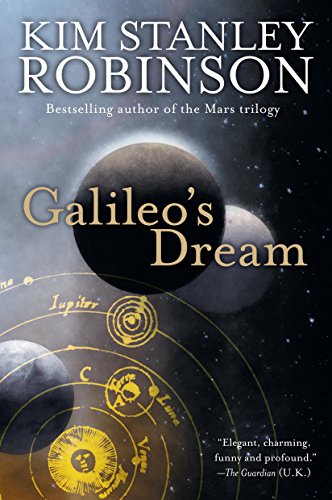
![]() Galileo’s Dream by Kim Stanley Robinson
Galileo’s Dream by Kim Stanley Robinson
I’m a huge fan of Kim Stanley Robinson’s The Years of Rice and Salt, which is a terrific blend of pseudo science fictional philosophy and religion, and fun and entertaining alternative history. It’s deep and touching and provides a strong sense of activity (if not specifically action and adventure). So the concept behind Galileo’s Dream drew me to the book the instant I read the description: the astronomer Galileo is taken from Earth to the moons of Jupiter (which he discovered) in an attempt to modify the past to make for a better future — a future in which science rises up over religion. Unfortunately, while it’s a fun concept, Robinson provides an uneven implementation.
The vast majority of Galileo’s Dream follows Galileo Galilei over the course of 30 or 40 years through his major astronomical discoveries and inventions. His is, by far, the strongest character throughout the book that includes a mix of humans from the future, Galileo’s daughters, and numerous other good and bad guys from 17th century Italy.
The first several times that Galileo is spirited away by “The Stranger,” the table is set for an interesting view of human life in the future, living on a moon of Jupiter. I was settling in for a nice space/time travel ride but became disappointed at the increasingly shorter visits to space and the future, and the increasing focus on philosophies of time travel, its impact on the past, and vagueness on the battles between science and religion.
These elements are interesting and good sci-fi fodder, however, I found them to be bluntly addressed and not well balanced with the minute details of Galileo’s daily travails and triumphs.
If you’re interested in a solid period piece, with strong historical research and a decent story, then I’d recommend Galileo’s Dream. But read with appropriately measured expectations.



I think Robinson, as a writer, is a great thinker.
I’ve gotten the same impression from reviews of his Mars Trilogy, Years of Rice and Salt, 2312, and Aurora. Great ideas, but heavy-going in the exposition and world-building details. That works for some readers and not others. The same can be said of Neal Stephenson.